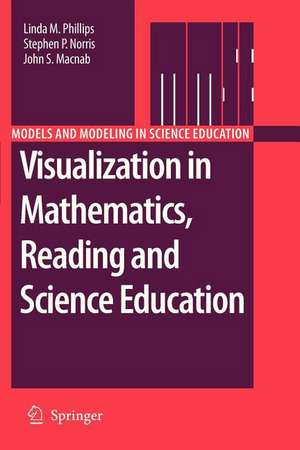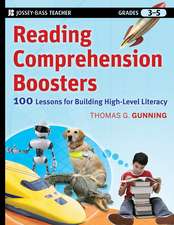Visualization in Mathematics, Reading and Science Education: Models and Modeling in Science Education, cartea 5
Autor Linda M. Phillips, Stephen P. Norris, John S. Macnaben Limba Engleză Paperback – 6 noi 2012
| Toate formatele și edițiile | Preț | Express |
|---|---|---|
| Paperback (1) | 545.69 lei 38-44 zile | |
| SPRINGER NETHERLANDS – 6 noi 2012 | 545.69 lei 38-44 zile | |
| Hardback (1) | 638.57 lei 6-8 săpt. | |
| SPRINGER NETHERLANDS – 17 sep 2010 | 638.57 lei 6-8 săpt. |
Preț: 545.69 lei
Preț vechi: 682.10 lei
-20% Nou
Puncte Express: 819
Preț estimativ în valută:
104.42€ • 113.78$ • 87.99£
104.42€ • 113.78$ • 87.99£
Carte tipărită la comandă
Livrare economică 19-25 aprilie
Preluare comenzi: 021 569.72.76
Specificații
ISBN-13: 9789400733350
ISBN-10: 9400733356
Pagini: 120
Ilustrații: XIV, 106 p.
Dimensiuni: 155 x 235 x 6 mm
Greutate: 0.18 kg
Ediția:2010
Editura: SPRINGER NETHERLANDS
Colecția Springer
Seria Models and Modeling in Science Education
Locul publicării:Dordrecht, Netherlands
ISBN-10: 9400733356
Pagini: 120
Ilustrații: XIV, 106 p.
Dimensiuni: 155 x 235 x 6 mm
Greutate: 0.18 kg
Ediția:2010
Editura: SPRINGER NETHERLANDS
Colecția Springer
Seria Models and Modeling in Science Education
Locul publicării:Dordrecht, Netherlands
Public țintă
ResearchCuprins
An Introduction To Visualization.- A Commonsense View and Its Problems.- A History of Visualization in Psychology and Science.- The Concept of Visualization.- Cognitive Theory.- Current Educational Research.- Visualizations and Mathematics.- Visualizations and Reading.- Visualizations and Science.- Cautions and Recommendations.- Research and Guidelines on Computer-Generated Visualizations.- Concluding Comments, Recommendations, and Further Considerations.
Textul de pe ultima copertă
Visualizations—either self-created or external visual stimuli used as an aid to learning—are probably as old as learning itself. Yet surprisingly little research has been done either into how precisely they help us learn, or how to produce ones that are effective pedagogical tools. This volume, a comprehensive review of theory and research on the use of visualization in mathematics, science and reading, contrasts the two dominant theoretical paradigms of how people construct and interpret visualizations. However, the authors never lose sight of practical applications, providing frequent, accessible synopses of research findings in addition to succinct summaries of how the research affects practice. Written by a team with decades of experience in research and practice in the three subjects, the chapters show how cognitive psychology can enhance practical pedagogy, place visualizations in their proper historical context, and analyze in detail the effectiveness of paper-, computer- and video-based visualizations, with some surprising results.The book is published at a time when, it seems, there is no limit to the art of creating visualizations, as powerful computers make graphics ever more colorful and realistic and ‘interactivity’ is firmly established as a buzzword in the educational lexicon. The aim of the volume is to explore some central questions in the field, including how to evaluate visualizations and whether or not they can act as an aid to reading development, and to mathematics and science learning. The authors also point to potentially fruitful subjects for future research, and offer their own conclusions and recommendations. As the debate continues over the value of visualizations, with polarized arguments on the one hand lauding them and on the other dismissing them as gimmicks, this book introduces a voice of reason to the discussion that will be welcomed by psychologists and educationalists alike.
Caracteristici
Provides a thorough review of theoretical and research literature Draws explicit connections between research and practice Links mathematics and science learning, and reading, in unique ways Written by experts in mathematics, science and reading education Applies cognitive psychology to practical pedagogy Places visualization in a historical context Analyzes paper-, computer- and video-based visualizations



















